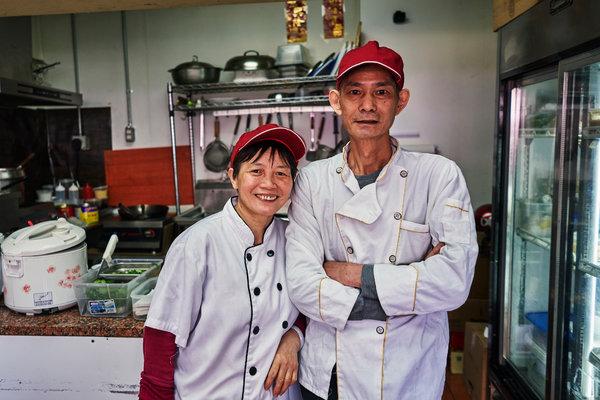There is a point at which a restaurant with an open kitchen becomes more kitchen than restaurant, and diners feel more like lucky house guests than paying customers. To conjure this effect, fine-dining establishments may send people home with a ribbon-tied Ball jar of quirkily flavored granola. Mama’s Noodle House, a small Chinese restaurant in Bensonhurst, Brooklyn, does it with five rice cookers of various models and an expandable dining table that moonlights as a dumpling-folding station.
This table is where you may find Nan Yi Liang when she isn’t doubling as the restaurant’s one-woman wait staff. She and her husband, Jai Kei Sung, a co-owner and co-chef, fold up to 1,000 dumplings (pork, for frying) and won tons (pork and shrimp, for boiling) every night, lining them up like tessellations on a baking sheet. If a party larger than two arrives, Ms. Liang will quickly transfer her setup to a counter seat along the wall, move the table into the center of the brightly lit room, pull out chairs and then warmly hurry her diners into them as she pours each a small cup of freshly brewed tea.
Ms. Liang opened Mama’s Noodle House about a year ago, in a space previously occupied by a combination Sichuan restaurant and electronics store run by a friend. She and Mr. Sung, chefs from Guangzhou, China, who immigrated to Amsterdam in the 1970s, had long wanted to open a restaurant together. They moved to Bensonhurst in 2001 after the birth of their daughter, Cindy, who is now 20 and helps out behind the scenes at Mama’s.

Nan Yi Liang and Jai Kei Sung run Mama’s Noodle House, in Bensonhurst, Brooklyn. Together, they fold up to 1,000 dumplings a night.CreditAn Rong Xu for The New York Times
Initially, Ms. Liang ran the place and focused on her specialties: dumplings, won tons and other dishes that offered an efficient ratio of prep time to flavor, as well as noodle soups and Sichuan hot pot. When Mr. Sung began working at the restaurant full time in January, the menu expanded to reflect the decade or more he had spent cooking in Thai and Korean restaurants. Their chicken ho fun borrows from Thai cooking, with strips of basil twisted through its wide noodles like a half-finished braid.
Those rice cookers, which line the counter between the cooking space and the eating space, act as holding pens for braised beef, cumin-blasted ground Sichuan pork and the beef-pork stock that the couple makes fresh every morning. All three ingredients come together in the signature Mama Noodle Soup: The meat is carefully arranged atop Shanghai-style noodles, and nestled alongside bouncy fish balls and tea eggs in a brothy mosaic. The pork, cooked down until concentrated into a paste, floats into every bite, while the braised brisket holds its shape, its star anise-infused flavor radiating out into the rest of the dish.
The hot-pot fish — Mama’s most expensive dish, at $10 — appears in not one but two posters on the wall. If you take this to mean you should order it, you are right. The hot pot gleams with a topcoat of chile oil that’s such a deep red it nearly camouflages a handful of dried chiles lurking under a canopy of chopped cilantro and scallions. The broth gets a tangy kick from the ginger simmered into it; the result almost tastes as if it’s been finished with vinegar. The flounder absorbs the floral scent of Sichuan peppercorns that have been steeped into the liquid with licorice root, star anise and cinnamon. Individual servings come in plastic bowls, but groups of three or more can order the more traditional large-format hot pot.
Mama’s officially closes at 9:30 p.m., but dumpling demand is now so high that it often stays open until 10 or 11, just so Ms. Liang and Mr. Sung have time to fold what they need. A takeaway bag of 40 won tons sells for $10, and even after a good sit in a freezer, their freshness asserts itself when they’re cooked: delicate jellyfish-like edges adorn bellies fat with pork and chives, each holding a pert bite of shrimp like a prize.
Ms. Liang has occasionally experimented with other flavor variations. She tried making vegetarian dumplings, but the ingredients were too expensive; she keeps a secret stash of pork dumplings studded with corn, carrot and cilantro. “I’m telling them to up their prices,” Ms. Sung said of her parents, but so far, they haven’t budged.
On a recent evening, after buying a few bags to bring home, my friends and I asked how much inventory Ms. Liang had left in the large chest freezer. She laughed, opened the door to show a near-depleted stash of dumplings, and chided us for running off with so many. A stack of won-ton wrappers and a bowl of pork and shrimp sat on the counter, waiting to be folded together once we left.
Follow NYT Food on Twitter and NYT Cooking on Instagram, Facebook, YouTube and Pinterest. Get regular updates from NYT Cooking, with recipe suggestions, cooking tips and shopping advice.




